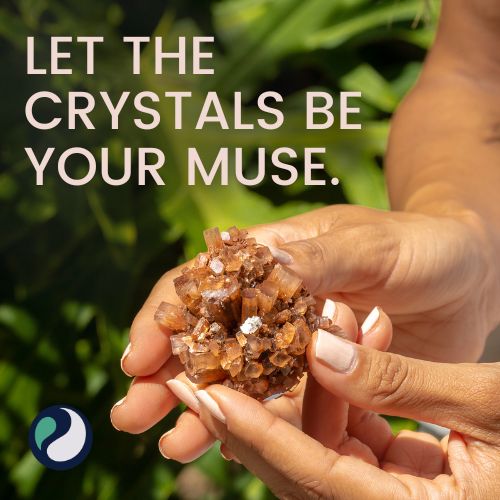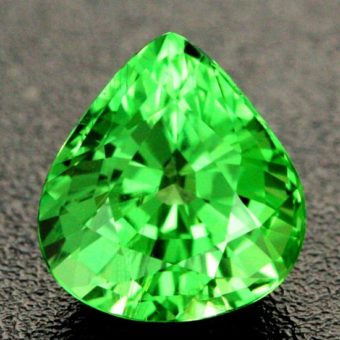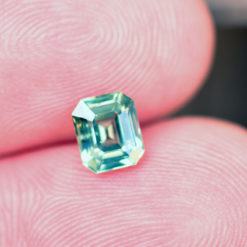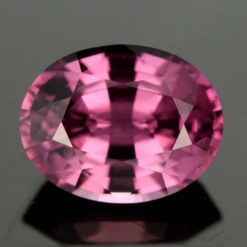No products in the cart.
Gemstone Information
Tsavorite vs Emerald: Battle Of The Green Gems
In the captivating world of gemstones, the allure of green gems holds a special place. Among these, Tsavorite and Emerald stand out, each with its unique charm and beauty. “Tsavorite vs Emerald: Battle Of The Green Gems” is more than just a comparison; it’s a journey into the heart of what makes these stones so enchanting and sought after.
Tsavorite, a gemstone that has risen in popularity in recent years, offers a vibrant, electric green hue that is both rare and mesmerizing. Its journey from discovery to being a coveted jewel is as fascinating as the stone itself. On the other hand, the Emerald, with its rich, deep green, has been a symbol of opulence and allure for centuries. This gem’s history is intertwined with that of empires and royalty, making it a timeless classic in the world of precious stones.
In this exploration, we delve into various aspects that define and distinguish these two green beauties. From their mineral composition and geographical origins to their place in the world of jewelry and fashion, each facet of Tsavorite and Emerald tells a story. This article aims to illuminate these stories, offering a comprehensive guide that not only compares but also appreciates the unique qualities of each gemstone.
Gemstone Overview
Tsavorite
The Tsavorite, a gem that bursts with a vibrant, electric green, is a recent discovery in the gemstone world, having first been found in the 1960s in Kenya. This rare gemstone is a variety of the mineral garnet and is renowned for its bright, rich color that ranges from a spring green to deep forest hues. Its discovery by Campbell R. Bridges, a British geologist, introduced a fresh and vivid alternative in the green gemstone market, traditionally dominated by emeralds.
One of the key properties of Tsavorite is its natural clarity. Unlike many other gemstones, Tsavorite is rarely treated to enhance its color or clarity, making it an exceptional choice for those who value natural beauty. Moreover, its durability, scoring 7 to 7.5 on the Mohs scale, makes it suitable for everyday wear, adding to its growing popularity in jewelry.
Emerald
Emeralds, on the other hand, have been cherished for their exquisite beauty since antiquity. Known for their signature deep green, Emeralds are a form of beryl and often contain inclusions, sometimes referred to as “jardin,” which are accepted by enthusiasts as part of their natural character. These inclusions generally make emeralds less durable than Tsavorites, with a Mohs scale rating of 7.5 to 8, but their enchanting hues and historical significance continue to captivate.
The allure of Emeralds is deeply rooted in history, with some of the earliest mines dating back to ancient Egypt during the reign of Cleopatra. The stone’s rich green has been a symbol of rebirth and love, making it a timeless choice in jewelry. Historically significant and culturally profound, Emeralds have adorned the collections of royalty and fashion icons alike, showcasing their undiminished appeal.
Comparative Overview
While Tsavorite and Emerald both offer stunning shades of green, they differ in their geological makeup, history, and characteristics. Tsavorite’s recent discovery and natural clarity position it as a unique and fresh choice, whereas the Emerald’s rich history and traditional elegance offer a timeless allure. Both stones, with their distinct shades and properties, continue to fascinate gem enthusiasts and jewelers around the world, each telling their own story of nature’s beauty.
Physical and Chemical Properties
When exploring the allure of Tsavorite and Emerald, understanding their physical and chemical properties is key to appreciating their uniqueness and the factors that distinguish one from the other.
Tsavorite’s Composition and Structure
Tsavorite is a variety of the garnet group, specifically a grossular garnet. Its vibrant green color is primarily due to the presence of vanadium and sometimes chromium. Unlike many other gemstones, Tsavorite is not treated for color enhancement, making its natural vividness a remarkable feature. In terms of hardness, Tsavorite ranks between 7 and 7.5 on the Mohs scale, offering good durability for daily wear. This makes it a practical choice for various types of jewelry, including rings and bracelets that are subject to frequent contact.
The crystal structure of Tsavorite is also notable. It typically forms in metamorphic rocks and is often found in small sizes. Finding large Tsavorite gems is rare, which significantly increases their value as the size increases. The clarity of Tsavorite is generally high, and it’s less prone to inclusions compared to Emerald, making it an excellent choice for those seeking a gem with fewer internal characteristics.
Emerald’s Unique Traits
Emeralds are a form of beryl and are chemically distinct from Tsavorite. Their lush green color comes from trace amounts of chromium and sometimes vanadium. Unlike Tsavorite, Emeralds often contain inclusions and internal fractures, a characteristic so common that it has its own name: “jardin,” French for garden. These inclusions are not necessarily seen as flaws but rather as evidence of the gemstone’s natural formation and individuality.
Emeralds rate slightly higher on the Mohs scale, typically between 7.5 and 8, but their frequent inclusions can make them more prone to breakage if not handled carefully. This aspect is crucial for jewelry settings, as it demands more protection for the Emerald to ensure its longevity.
Emeralds are also commonly treated with oils or resins to enhance their clarity and stability. This treatment is a widely accepted practice in the gemstone industry and helps to preserve the beauty of the Emerald over time.
Geographical Origins
The geographical origins of Tsavorite and Emerald not only contribute to their mystique but also play a significant role in their value and characteristics. Each of these green gems is deeply rooted in specific parts of the world, with their origins adding to their story and allure.
The African Roots of Tsavorite
Tsavorite’s story begins in the wild landscapes of East Africa. This gemstone was first discovered in the Tsavo National Park area, straddling Kenya and Tanzania, hence its name, ‘Tsavorite.’ The unique geological conditions of this region, characterized by ancient metamorphic rocks, are ideal for the formation of Tsavorite. This geographical exclusivity adds to the rarity and value of Tsavorite, making it a cherished find in the gemstone market.
The East African Rift system, with its rich diversity of minerals, is the primary source of Tsavorite. The mines in this region are often small and less industrialized compared to other gemstone mining operations, which adds a layer of uniqueness to each stone sourced from these areas. The limited geographical range from which Tsavorite can be sourced has a direct impact on its availability and price, especially for larger, high-quality stones.
Emeralds: From Ancient Seas to Mountain Mines
Emeralds have a more widespread geographical footprint, with significant sources found in Colombia, Brazil, Zambia, and Russia, among others. The most prized emeralds come from the lush green valleys of Colombia, where conditions for the formation of emeralds are near perfect. Colombian emeralds are renowned for their exceptional quality and vibrant color, often considered the benchmark for this gemstone.
The formation of emeralds is typically linked to hydrothermal processes, where beryl-rich solutions interact with the Earth’s geology under specific temperature and pressure conditions. This process can happen in various geological settings, which explains the wider distribution of emerald mines around the world compared to Tsavorite.
Impact of Origin on Gemstone Quality
The origin of a Tsavorite or Emerald not only tells a story of its journey from earth to jewel but also influences its appearance and quality. For instance, Colombian emeralds are often prized for their slightly bluish-green color, while Zambian emeralds may exhibit a more vivid green hue. Similarly, the Tsavorite from Kenya and Tanzania is celebrated for its rich, radiant green, often without the need for any enhancing treatments.
In the realm of fine gemstones, the origin often carries weight in determining value, but it’s the individual quality of each gem that ultimately captivates and compels. Whether it’s the vibrant green of a Tsavorite from the African plains or the deep, lush hues of a Colombian emerald, the geographical origins of these stones are a testament to the diverse beauty of our planet.
Durability and Maintenance
Understanding the durability and maintenance requirements of Tsavorite and Emerald is essential for anyone considering these gems, whether for personal adornment or as part of a collection. Both stones offer unique considerations in terms of care and longevity.
Tsavorite: Resilience and Care
Tsavorite, ranking between 7 and 7.5 on the Mohs scale of mineral hardness, exhibits a commendable degree of durability. This makes it suitable for everyday wear, although, like all gemstones, it requires care to maintain its luster and prevent damage. Tsavorite’s resistance to scratching and abrasion is relatively high compared to softer gemstones, but it can still be susceptible to hard impacts.
When it comes to maintenance, Tsavorite can be cleaned using warm soapy water and a soft brush. It’s important to avoid harsh chemicals or ultrasonic cleaners, as these can potentially damage the stone. For those who wear Tsavorite in rings or bracelets, it’s advisable to remove the jewelry during strenuous activities to prevent accidental knocks or scratches.
Emerald: Delicate Beauty
Emeralds, with a slightly higher Mohs hardness rating of 7.5 to 8, might appear more durable than Tsavorite on paper. However, their natural inclusions can make them more prone to cracking or chipping. This characteristic demands careful handling and thoughtful setting in jewelry to protect the stone from impact.
The maintenance of Emeralds requires a gentle touch. They are often treated with oils or resins to fill surface-reaching fissures and enhance clarity, which can be affected by exposure to high heat or certain cleaning solutions. Cleaning Emeralds with mild soapy water and a soft brush is the safest method. It’s generally recommended to avoid ultrasonic and steam cleaners, as these can remove the oils and affect the stone’s appearance.
Jewelry and Usability
Tsavorite and Emerald, with their distinct shades of green and unique properties, offer diverse options for jewelry enthusiasts. How these gems are incorporated into jewelry not only reflects their individual characteristics but also the trends and preferences in the world of fine jewelry.
Tsavorite in Jewelry Design
Tsavorite, known for its bright and vivid green color, has become increasingly popular in contemporary jewelry design. Its robustness, with a Mohs hardness rating suitable for daily wear, makes it a versatile choice for various types of jewelry. Tsavorite’s brilliance and high clarity make it an excellent option for pieces where the gemstone is the focal point, such as in solitaire rings or pendant necklaces.
The ability of Tsavorite to be cut into various shapes and sizes allows for creative and innovative designs. It pairs beautifully with both white and yellow metals, offering designers the flexibility to craft pieces that range from classic elegance to modern chic. Tsavorite’s increasing popularity is also due to its relatively more affordable price compared to Emerald, making it accessible to a broader range of jewelry lovers.
Emerald’s Timeless Appeal
Emerald has long been a staple in fine jewelry, revered for its deep, rich green hue and the subtle, internal “jardin” that adds to its unique character. Due to its slightly softer nature and the presence of natural inclusions, Emeralds are often cut in the traditional emerald (step) cut, which not only enhances their color but also provides stability to the stone.
Emeralds are a classic choice for more formal and high-end pieces, often set in engagement rings, statement necklaces, and luxury watches. They are frequently paired with diamonds, which complement their green with sparkling brilliance. The setting of Emeralds typically involves extra care to protect the stone from impact, making bezel and prong settings popular choices.
Historical and Cultural Significance
The allure of Tsavorite and Emerald extends beyond their physical beauty, deeply rooted in rich histories and cultural significances that span across centuries and civilizations. Each gemstone carries with it a tapestry of stories and meanings that have evolved over time.
Tsavorite: A Modern Gem with Ancient Roots
Despite its relatively recent discovery in the 1960s, Tsavorite is linked to the ancient geological history of East Africa. Its presence in this region, known for its rich mineral resources and diverse natural landscapes, adds a layer of intrigue and fascination. Tsavorite’s discovery by Campbell Bridges marked a significant moment in gemology, bringing a new player into the world of colored gemstones.
While Tsavorite does not have the lengthy historical background that many other gemstones boast, its quick rise to popularity reflects contemporary tastes and trends in gemstone jewelry. It symbolizes innovation and exploration, embodying the spirit of discovery in the modern world. Tsavorite has also gained cultural significance in its native regions, contributing to local economies and representing the natural beauty of East Africa.
Emerald: A Gem of Empires and Legends
In contrast, Emerald has a storied history that dates back to ancient civilizations. Revered by the Incas and Aztecs, mined in Egypt as far back as 330 BC, and sought after by European royalty, Emeralds have always been a symbol of power, luxury, and beauty. Cleopatra, the famed queen of Egypt, was known for her love of Emeralds, and they were a favorite gemstone in ancient Rome, where they were associated with Venus, the goddess of love and beauty.
Over the centuries, Emeralds have maintained their status as a coveted jewel in various cultures. In many societies, they have been believed to possess mystical powers, from being a source of eternal youth to acting as a talisman that wards off evil. The deep green color of Emeralds has often been associated with the renewal of life and the natural world, making them a symbol of growth, fertility, and prosperity.
Conclusion
As we conclude our exploration of Tsavorite and Emerald, the “Battle Of The Green Gems,” it becomes evident that each of these stunning gemstones holds its unique charm and allure. While they share the commonality of a captivating green hue, their differences in origin, physical properties, historical significance, and their use in jewelry highlight the diverse beauty that nature offers.
Tsavorite, with its vivid, electric green color and higher clarity, represents a modern twist in the world of gemstones. Its resilience and unenhanced natural beauty make it a practical and increasingly popular choice for various types of jewelry. The story of Tsavorite is one of discovery and innovation, embodying the evolving tastes and preferences in contemporary gemstone jewelry.
Emerald, on the other hand, carries the weight of history and tradition. Its deeper, more classic green hue, often accompanied by characteristic inclusions, has been a symbol of luxury and elegance for centuries. Despite its need for more careful handling, the Emerald remains a timeless choice, steeped in cultural significance and adorned for its mystical and historical associations.
The decision between Tsavorite and Emerald is not merely one of aesthetic preference but also a reflection of individual style, the intended use of the gemstone, and a connection to the unique story each gem tells. Whether it is the modern vibrancy of Tsavorite or the traditional elegance of Emerald, both gems offer unparalleled beauty and an opportunity to own a piece of the Earth’s natural splendor.
In summary, Tsavorite and Emerald stand as two magnificent pillars in the world of green gemstones, each offering its distinctive beauty and charm. As symbols of nature’s diversity and richness, they continue to captivate gem enthusiasts and jewelers alike, ensuring that the battle of these green gems remains a testament to the enduring allure of nature’s treasures.



















